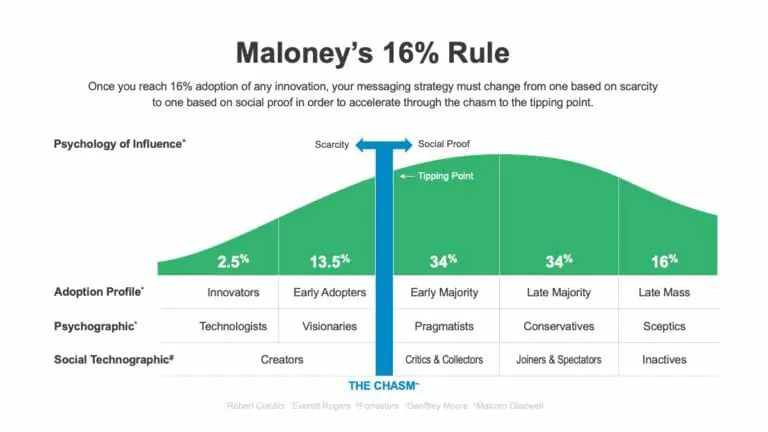
COVID-19 has dramatically reshaped our culture. In particular, the pandemic has exponentially increased the speed at which businesses are adopting technology. Top companies are investing in new tech on a weekly basis, compared to years prior which was, at best, monthly or quarterly.
According to a recent survey by McKinsey & Company, top performing organizations have invested heavily in cloud-based infrastructures, cybersecurity, and hiring new talent to fill the talent gap in technology. The survey repeats throughout that laggards will have a major challenge catching up to their competitors who are “technologically endowed.”
So, where on the spectrum of the diffusion of innovation do you want your business to be? Innovators and early adopters are eager to accommodate new technology and try new ways to increase performance. Better tech capabilities are directly linked to better economic yield. We’ll guide you through the stages of technology adoption, problems associated with lag, and how to be a leader in the construction industry’s notoriously slow adoption of new tech.
The Five Stages of the Diffusion of Innovation
The Diffusion of Innovation, a theory popularized by researcher Everitt Rogers in 1962, explains how over time an idea or product gains momentum through demographic and psychological characteristics of defined groups. It highlights how people adopt a new idea, behavior, or in this case, technology.
Technology adoption refers to the acceptance, incorporation and mobilization of new technology. The five stages of this lifecycle are based on how fast these groups (by percentage) are jumping on the wagon compared to the rest of the population.

Innovators (2.5%)
The smallest group in the lifecycle, innovators are risk-takers. They are more radical when it comes to technology and the first to adopt. They don’t mind if the product is brand new on the market, they’re happy to be the testers and contribute to product development and advancement.
Early Adopters (13.5%)
Early adopters are more likely to be opinion leaders or influencers. This group is more selective with their purchase choices and has done extensive research watching the market closely for innovative products.
Early Majority (34%)
This is the conscious consumer. Early majority members are comfortable with changing their purchase behaviors but are looking for useful solutions. They are more conservative with their technology adoption and need it to be vetted by peers and colleagues.
Late Majority (34%)
The late majority group is mainstream. Products must be well established to be adopted by these members. They are skeptical of innovation and wait for feedback from early adopters to make their purchase decisions. Perhaps these members have accepted technology in their personal life – a smart phone, smart TV, even a smart home security camera – but resist new innovative tech at work.
Laggards (16%)
Laggards are averse to innovation. They are traditionalists and focus on the past generation’s decision making. There could be economic or personal reasons that prevent them from adopting new technology as well.
What Happens to Your Construction Business When You Stall on Technology
Your business model becomes obsolete.
Construction has the highest single failure rate of all industries, and a lot of that is driven by a failure to adopt technology. Leading companies are far ahead of competitors in building their tech troops. The time is now to make bold investments in tech and talent that will equip your business to outperform competition in an ever-evolving landscape.
Your data fails you.
Whether it’s a computer hard drive crash, damaged or lost paper blueprints, or only having one person with access to your data, you put your company at risk for inefficiencies and data failures. Investing in cloud-based preconstruction technology like STACK will prevent these pitfalls.
Poor collaboration.
Without an organized infrastructure to track and share information (inside and outside of your company), you risk financial exposure, scheduling issues, and tarnishing your reputation within the industry. Learn how to improve collaboration with new technology to stay in the game.
Insufficient or no cybersecurity.
Your company’s network is at high risk of viruses or unauthorized access into system controls without a solid cybersecurity protection plan. Everything is turning digital. Even HVAC systems are vulnerable as they can be virtually compromised through smart thermostats. Safeguard your data with a cloud-based platform that has an airtight security feature.
How To Be a Tech Leader in the Construction Industry
Understand What Digital Adoption Really Is
So what is technology adoption? Contrary to popular belief, it’s not just building a website, advertising through social media, or upgrading your IT. It’s a complete business transformation with new software to streamline operations. Make sure that new software is cloud-based so you have one source of truth for your company’s data.
Training Your Employees for Tech
Good leaders know their teams well. Not everyone learns at the same pace or with the same technique. Offering different choices for training – the buddy system, software with training programs, fun and friendly competitions – will make easing into change seamless.
Attract a Talented Tech Workforce
Competition for top talent is brutal, and these folks have choices between industry and location. They tend to be Gen-Z and Millennials, who are tech savvy and tech reliant. If your company is at the forefront of tech, by using cloud-based software like STACK you’ll be attracting the budding workforce you need to succeed. Be trendy with the younger generations and #adopttech.
Differentiate Yourself from Competitors
Invest in new technology frequently. According to the McKinsey survey results, in 2021 the funding of digital and technology initiatives in top-performing companies increased by 65%, as did the numbers of full-time equivalents in a digital and technology role by 44%.
How to Choose the Right Construction Technology for Your Business
1. Select technology that will solve an identified business problem
2. Plan for implementation, considering your staff and infrastructure
3. Communicate the change internally before and after adopting
4. Set up a solid training plan for all employees
We hope in the very near future the word traditionalist no longer refers to the cycle’s laggard category, but rather the innovators. Adopting technology in the construction industry will not only directly affect your profitability but keep your business model relevant and competitive. Do you want to be Blockbuster or Netflix? Be a pioneer in construction – you’ll thank us later.






